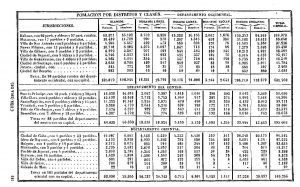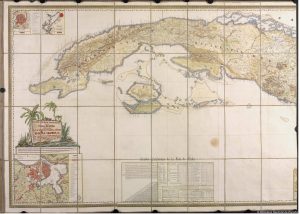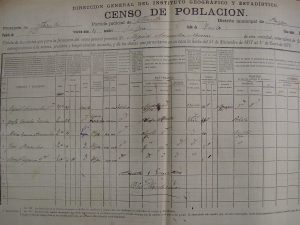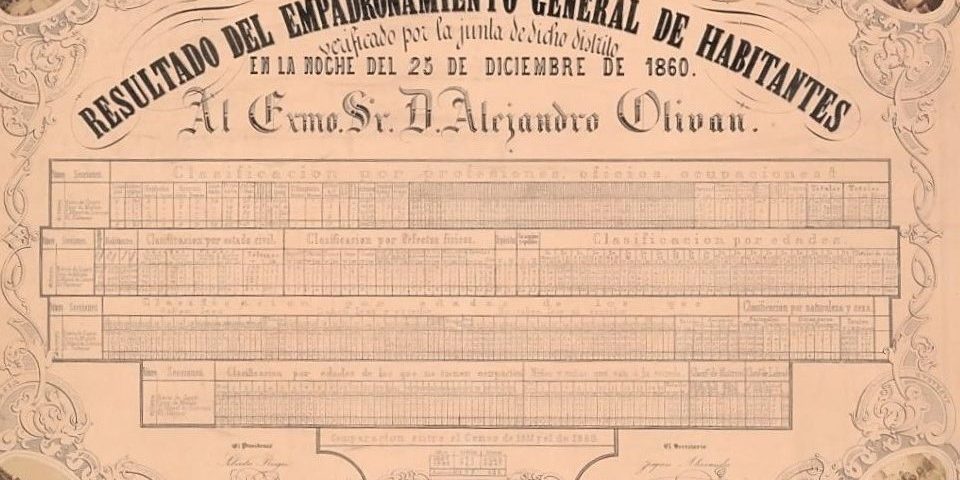


The Environment and the Modernity of Political Ideas
12 February 2022
Civilians and Fallen Pilots in Europe, 1939-1945
12 February 2022The Birth of the Census in Spain and its Empire in the 19th Century

How did the Spanish state set up a census of its populations in the mid-19th century? How, but also why? Censuses do not just count populations, but also inform, describe, and classify, thereby serving many goals. It is also important to understand which of these objectives the Spanish state was pursuing as it contended with strong local identities and helmed an Empire in decline. Mathieu Aguilera grapples with these questions in ‘The Search for Truth. Censuses and Statisticians in 19th-century Spain’, a thesis completed jointly at Sciences Po and the Universidad Autónoma de Madrid. The breadth of his findings and the depth of his analyses earned him the prestigious 2021 thesis prize from the Chancellerie des Universités de Paris. Interview.
What sparked this project?
Mathieu Aguilera: The main spark was probably a question that came up during the research I conducted while writing my M2 dissertation at Paris I Panthéon Sorbonne, after obtaining my master in History at Sciences Po. I was examining the history of the Hispanic world at the beginning of the 19th century, and state building from the perspective of intermediaries of the authorities in societies steeped in the political, legal, and religious culture of the Ancien Régime. The research focused on an urban local police force: the alcalde de barrio. The force was formed in Madrid after the 1766 unrest, which led the reformer monarch Charles III and his ministers to come up with new ways to relay their authority to residents, with the creation of ‘neighbourhood mayors’. During this research I realised that one of the essential but sensitive tasks entrusted to these institutionalised intermediaries was the annual compilation of lists of neighbourhood residents, house by house (padrón de vecinos). I was seeking to understand how these local lists that were often stored in the homes of these officials and created using very different methods, formed the basis of State knowledge about the population. In the process, I realised that no study had systematically analysed the political, social, and intellectual history of the population census in nineteenth-century Spain, considered in its peninsular and overseas dimension, as did many works on the ‘second empire’.
You studied the birth of a national population census that appeared in the 19th century. How did this plan come about? Was the Central State combating regional particularities in order to build a unified Spain?
M.A.: Although strongly linked to the trajectory of nation states and empires, and to the assertion of their sovereignty, the quest for official statistics was global and its institutional and intellectual frameworks were also forged transnationally. No state escaped this ‘statistical enthusiasm’, which in the 1820s and 1840s took the form of what the philosopher Ian Hacking has described as an ‘avalanche of printed numbers’. This keen interest in statistics and the ‘counting’ of the social world went far beyond public administrations. With the advent of a new conception of national territory and administration, as well as observation sciences, the census became the most ‘reliable’ means of counting the population. As the seminal work of Alain Desrosières has shown, the census became part of the inner workings of administrations and was discussed at the major International Statistical Congresses organised from 1853 onwards at the initiative of the Belgian astronomer and statistician Adolphe Quetelet, who had been running his country’s statistics office since 1841. These congresses sought to standardise procedures, disseminate ‘good practices’, and issue recommendations to make the figures produced by each national office comparable.
One of my research challenges was to reconstruct the stages of the institutionalisation of administrative statistics in relation to the administrative reform that spanned the entire century, while simultaneously reintegrating Spain into the transnational history; to uncover the areas of connection, translation, and encounter between senior Iberian officials and their European and American counterparts. The overwhelming influence of the French model and references among Spanish statisticians is striking. The plan for a direct, national, and exhaustive census was of a piece with the state model of the neo-absolutist reformers of the 1825s, and then of conservatives in the 1850s and 1860s, who called for a centralised and Catholic nation-state to overtake local particularities. These were essentially legal ones until the Catalan, Basque, and Galician nationalism took a cultural and then political turn in the 1890s. The implementation of a national statistical apparatus was, alongside cartography and the cadastre, a means of asserting sovereignty through knowledge of the national population, which it helped establish as a quantifiable and measurable reality. In addition, the fact that everyone filled out a form on the same day, requiring them, despite misunderstandings and resistance, to receive and accept the language of statisticians in order to be counted and identified, accompanied the rise of States in the governance of societies, and their claim to territorial control.
What political obstacles did this undertaking face?
M.A.: As everywhere else, the development of a public statistics administration elicited criticism, which was frequently raised in the opposition press. However, I did not find any evidence of large-scale revolts or riots during the field operations. These were more often directed against conscription offices, which large segments of society deemed iniquitous and hated. The census operations, entrusted to local authorities, were part of the ordinary and clientelistic mechanisms of local administration. I think this was one of the keys to the success of these surveys, which relied on multiple intermediaries. The diffuse opposition to the counting was reflected in multiple forms of concealment, avoidance, or fraud.

Resumen del censo de población de la Isla de Cuba a ÿn del año de 1841. Source : La Havane, Imprenta
del Gobierno por S.M., 1842.
The orchestrators of census operations and their field agents also faced cognitive difficulties. The census relies on ‘equivalence conventions’, primarily statistical individualism, which are developed through trial and error and debate. This was the case, for example, in the quantification of activities and social positions – an operation that raised innumerable design and implementation difficulties (Who to count? Who contributes to wealth? How to aggregate the data? should individuals be asked to self-identify during the census?) – and in the establishment of the taxonomy of subjects of the colonial empire. In the Spanish West Indies, this taxonomy inherited ‘caste society’ categories of the modern age, rearranged in a binary way in the context of the Haitian revolution, in order to provide a ‘barometer of the balance of races’ between ‘whites’ and ‘people of colour’. Behind any operation counting and classifying numerical data lies a vision of social mechanisms and of the relations between these various elements to serve social engineering or biopolitical (more or less interventionist) purposes: my thesis also explores the political and intellectual stakes of this social ‘self-observation’, to use Jürgen Osterhammel’s expression in his global history of the nineteenth century.
From a technical perspective, specialised statisticians needed to be trained and intellectually and materially equipped. How did the State address these needs?
M.A.: Spanish statisticians were surprisingly absent in available studies when I started this survey. Almost nothing was known about their working methods, their concepts of statistics and population, and their relationship with the rest of the administrations and local authorities in charge of collecting the census figures. I therefore set out to establish a group portrait of the first cohorts of state statisticians, from the 1850s to the 1920s. In order to conduct the large decennial population censuses, the Geographic and Statistical Institute (Instituto Geográfico y Estadístico – IGE) created a corps of specialised statisticians in 1876. Around 150 active agents were recruited by competitive examination to form the Statistical Corps. These first administrators-statisticians shared what I have called a ‘culture of inspection’. Data collection was carried out in a climate of deep mistrust between the census office and the municipalities, which sometimes required laborious field inspections. In Spain, despite the ideal of statisticians carrying out ‘objective’ statistical surveys detached from single-minded management purposes, the Ministry of Finance (Hacienda) used IGE’s work to establish the basis for indirect taxation on consumption, which was the population abhorred… So much so that the ‘search for the truth’ takes on a very different meaning depending on the actors involved in the population count. In the three overseas provinces of Cuba, Puerto Rico and the Philippines, the situation was similar to that observed in other colonial empires, with the bulk of the operations entrusted to the army and the military engineering corps. The latter also had to rely on myriad local intermediaries: the police in the countryside and, above all, the sugar oligarchy. This ‘saccharocracy’ was sometimes reluctant to provide figures on plantations and slaves, especially when abolition became inevitable. The goal then became to conceal the continuation of a clandestine slave trade, which was theoretically illegal but an open secret that experienced a ‘golden age’ from 1810 to 1840. The publicisation of population figures in slave societies was therefore geopolitically significant…

Carta Geógrafo-topográfica de la Isla de Cuba,1835. Source. Biblioteca Nacional de España.
Considerable material challenges also existed, as one can imagine. Forms, paperwork, files, shelves, and ‘counting machines’ also played leading roles in this ‘concrete history of abstraction’, to use Jean-Claude Perrot’s expression. The general population censuses of the 19th century were undoubtedly the first efforts in history to compile and process Big Data, at an unprecedented scale. The individual and collective data that administrations needed to process far exceeded available material and human resources. In fact, it was during the U.S. census at the end of the 19th century that mechanography was invented. The Hollerith machine processed the collected data, which was transcribed into perforated cards. In Spain, this mechanisation did not occur until the late 1920s, initially in the municipal statistics offices of Barcelona. In 1860–1910, data processing required massive material and human infrastructure and constant discipline. The system could easily break down. It also faced roadblocks, such as when statistical officials had to deal with the insubordination of ‘temporary workers’ recruited in the villages for the arduous work of copying and counting. This history of the ‘little hands’ of the census is gendered: in some countries, these tasks were considered menial and entrusted to women. This was not the case in Spain, at least officially and according to the archives, until the Republic in 1931.
The material difficulties were compounded in the census of colonial territories that were sometimes poorly controlled by the administration. For the second general census, in 1860, the director of the census office insisted that the distribution of forms take place on the same day throughout the empire, from Manila to Madrid, and from Seville to Havana… It took the governor of Cuba a year and a half to send back figures (which the administrators deemed to be of good quality, however), and the Philippines were never counted: the indigenous communities escaped (literally) the few census takers sent by the colonial Hacienda. The bulletins and forms sent from the Peninsula were nibbled by tropical insects, becoming unusable… It was an epic failure. Traditional calculation and estimation methods were used, based on partial tax lists and figures provided by religious authorities (especially the orders), which were better established in the archipelago than the civil administration.
Once the statistics were produced, what were they used for, and by whom?
M.A. :As the sociologist and statistician Olivier Martin recalled in his history of quantification, ‘the need for statistics is not a simple matter of curiosity or disinterested knowledge’. In the 19th century, census data was largely conceived, collected, and then used for management and administrative purposes, and was a means of ‘exercising power’. Depending on the national configuration, academic interests sometimes penetrated the ministries. This was not really the case in Spain, where they were primarily used to organise the distribution of state services, the number of schools that municipalities needed to maintain, road mapping by civil engineers, the classification of courts, and the division of the electoral map. But what most crystallised negotiations around the census was the fiscal scope of operations. The census figures were the subject of bitter negotiations because they involved the socio-fiscal pact between the state and local elites at the heart of the 19th-century Spanish political system. Spain’s statistical office was more of a ‘control administration’ than a place for the administration and the academic and reformist spheres to intersect. The intersection could occur in other academic and administrative spaces (medical, sanitary, and municipal reform, for example) that were more innovative in handling statistics and mathematics covering reproductive phenomena, mortality, public health, and labour issues..

Bulletins du recensement de 1877 (municipalité d’Albacete)
Source : Archivo Histórico Provincial de Albacete, Municipios.
In the overseas provinces, towards the end of the 18th century the regular census started addressing the new police, military, economic, and migratory challenges facing the colonial state and the oligarchy of planters. This raised the question of the history of the use of ethno-racial statistical categories forged during imperialism (that of ‘whiteness’ and ‘people of colour’) and expressed in the Spanish West Indies in the context of fear of the slave uprising and of a conspiracy among ‘free men of colour’, and then fear of an ‘Africanisation’ of Spanish territories. Accounting for these ‘empire tensions’ led me to outline a constellation of demographic fears objectified by large numbers. This fear is currently resurfacing every time the Federal Census Bureau of the United States publishes new figures…
Has this research led you to new research problems? What projects are you currently working on
M.A.: As a continuation of my dissertation, I am working on the organisation and implementation of the 1920 census, marked by the development of a new socio-professional nomenclature and a survey on fertility. I also plan to continue my research on the colonial stakes of population statistics, particularly during the ‘colonial reinvention’ of the Spanish West Indies (1790–1840) in contact with other European empires, and in relation to the medical and economic knowledge of the colonial State and the plantation oligarchy in the age of ‘second slavery’.
Another project is also dear to me. After discovering a fascinating legal file with many unexpected resonances, I am trying to reconstitute the case that in the 1830s led the protagonist, an ‘ultraroyalist fury’ from Madrid, to the scaffold in the midst of the Carlist war. In this examination of the ‘last witch’ of Spain, the idea is to study the creation of internal enemies in times of civil war. But it is also about the death penalty and gendered designations within ‘respectable liberalism’ of urban space transformations, of the power of images … and of gossip.
Interview by Hélène Naudet, communication, Vice Presidence for Research
Mathieu Aguilera, associate professor at the Toulouse Academy, is a researcher at Sciences Po’s Centre for History. He is a member of the editorial board of the journal Tracés. Revue de Sciences humaines and member of the Trayectorias del XVIII-XIX iberoamericano cluster within the international network Red Columnaria. He is also associated with the project Welfare State and Gender in Spain. New Historical Approaches (1880–1936), funded by the Spanish Research Agency.



